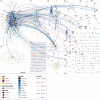Scientific Twitter: The flow of paleontological communication across a topic network
- PMID: 31361749
- PMCID: PMC6667199
- DOI: 10.1371/journal.pone.0219688
Scientific Twitter: The flow of paleontological communication across a topic network
Abstract
The field of paleontology, which is based principally on observations of the natural world, includes an active community that is engaged across multiple social media platforms, consisting of museums, academic researchers, amateur fossil collectors, paleontological artists, and commercial fossil dealers. As such, it represents an ideal environment for examining the people, interactions, and flow of scientific information. Using interactions involving the four most popular Twitter hashtags for paleontology, this embedded mixed methods study defined the members of this social world and investigated how they influenced and controlled the flow of information, as well as how their expression of scientific practice was related to their identity. Results provide further evidence for the diversity of people and practice involved in this domain of science and indicate that the magnitude and breadth of the public's impact may be larger than previously projected. Certain types of messages were shown to be effective for different segments of the community, but news posts, essentially media outlet stories, were ineffective for generating any form of engagement. This study adds to our understanding of the important scientific contribution being made by members of the public as they interact with professional scientists and educators as peers in an open social media platform that supports a diverse and active community.
Conflict of interest statement
The authors have declared that no competing interests exist.
Figures




Similar articles
-
Platform Effects on Public Health Communication: A Comparative and National Study of Message Design and Audience Engagement Across Twitter and Facebook.JMIR Infodemiology. 2022 Dec 20;2(2):e40198. doi: 10.2196/40198. eCollection 2022 Jul-Dec. JMIR Infodemiology. 2022. PMID: 36575712 Free PMC article.
-
The Saudi Ministry of Health's Twitter Communication Strategies and Public Engagement During the COVID-19 Pandemic: Content Analysis Study.JMIR Public Health Surveill. 2021 Jul 12;7(7):e27942. doi: 10.2196/27942. JMIR Public Health Surveill. 2021. PMID: 34117860 Free PMC article.
-
Public Concern About Monitoring Twitter Users and Their Conversations to Recruit for Clinical Trials: Survey Study.J Med Internet Res. 2019 Oct 30;21(10):e15455. doi: 10.2196/15455. J Med Internet Res. 2019. PMID: 31670698 Free PMC article.
-
Analysis of Twitter Activity and Engagement From Annual Meetings of the Society for Vascular Surgery and the Society of Interventional Radiology.Ann Vasc Surg. 2021 Oct;76:481-487. doi: 10.1016/j.avsg.2021.03.011. Epub 2021 Apr 5. Ann Vasc Surg. 2021. PMID: 33831529 Review.
-
Social media in surgery: evolving role in research communication and beyond.Langenbecks Arch Surg. 2021 May;406(3):505-520. doi: 10.1007/s00423-021-02135-7. Epub 2021 Feb 28. Langenbecks Arch Surg. 2021. PMID: 33640992 Free PMC article. Review.
Cited by
-
Two-Year Experience in "Tweeting the Meeting" During the Scientific Sessions - Rapid Report From the Japanese Circulation Society.Circ Rep. 2020 Sep 25;2(11):691-694. doi: 10.1253/circrep.CR-20-0093. Circ Rep. 2020. PMID: 33693196 Free PMC article.
-
Who tweets climate change papers? investigating publics of research through users' descriptions.PLoS One. 2022 Jun 3;17(6):e0268999. doi: 10.1371/journal.pone.0268999. eCollection 2022. PLoS One. 2022. PMID: 35657791 Free PMC article.
-
Analysing the effectiveness of Twitter as an equitable community communication tool for international conferences.PeerJ. 2023 May 8;11:e15270. doi: 10.7717/peerj.15270. eCollection 2023. PeerJ. 2023. PMID: 37180583 Free PMC article.
References
-
- Dickinson J, Bonney R. Citizen Science: Public participation in environmental research Ithaca, NY: Comstock Publishing Associates; 2012.
-
- Ries L, Oberhauser K. A Citizen Army for Science: Quantifying the Contributions of Citizen Scientists to our Understanding of Monarch Butterfly Biology. Bioscience. 2015. April 1;65(4):419–30.
-
- Wenger E, White N, Smith JD. Digital habitats: stewarding technology for communities Portland, OR: CPsquare; 2009.
-
- Gibson JJ. The ecological approach to visual perception Hillsdale, N.J.: Lawrence Erlbaum Associates; 1986.
Publication types
MeSH terms
LinkOut - more resources
Full Text Sources
Research Materials

